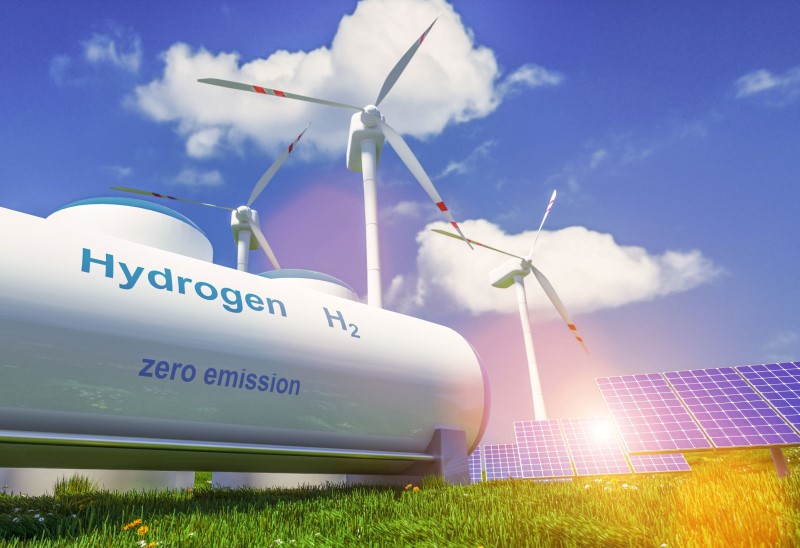UK Government Sets Out Strategy for a Hydrogen Economy
LONDON (Reuters) — The British government launched a strategy on Tuesday to meet its goal of 5 gigawatts (GW) of low-carbon hydrogen production by 2030 to replace natural gas in powering around three million homes, as well as industry and transport.

Industry and policymakers are increasingly looking to hydrogen to lower the environmental impact of sectors that have been the hardest to decarbonize and reduce the use of gas, but the investment required and the technical challenges are high.
Nearly all the hydrogen produced in Britain so far is based on fossil fuel energy.
The government aims to replace up to one fifth of natural gas with "green" hydrogen, made through electrolysis powered by renewable energy to split water into hydrogen and oxygen.
It would also use "blue" hydrogen, produced from natural gas and steam. Unlike green hydrogen, blue hydrogen is not emissions-free, but the carbon emissions are captured, stored and used in other applications.
The government said around 900 million pounds ($1.25 billion) of funding will be available to support hydrogen projects in Britain, which it said could create more than 9,000 jobs by 2030.
As part of the strategy, it has launched a consultation on types of support for hydrogen projects that could lower costs, along the lines of its contracts-for-difference (CfD) scheme that incentivizes investment in renewable energy by guaranteeing a minimum price for those who produce it.
The government will also work with industry on the feasibility of mixing 20% hydrogen into the existing gas supply.
It will also consult on the design of a 240-million-pound net zero hydrogen fund to support the commercial development of low-carbon hydrogen plants.
LAGGING EUROPE
The European Union also has high hopes that hydrogen will help in the meeting of low carbon goals.
Last year, the Commission, the EU executive, mapped out a strategy to prioritize green hydrogen for use in sectors that are hard to decarbonize, such as steel.
British multinational chemicals company INEOS, Europe's largest producer of hydrogen, said it saw a hydrogen economy as the country's best chance of meeting carbon reduction targets.
"But the government must start to commit to investment in the development of the UK’s hydrogen infrastructure," INEOS Corporate Affairs Director Tom Crotty said in a statement on Tuesday. "At the moment, we are massively lagging behind Europe and words are not enough."
Britain produces around 27 terawatt hours (Twh) of hydrogen a year, mostly from fossil fuels.
According to the UK government's climate change adviser to the Committee on Climate Change, to meet the government's net zero emissions goal by 2050 would require 270 TWh of hydrogen, mostly blue. Over a year, 1 GW equates to 8.76 TWh of energy.
Some environmental groups say the inclusion of blue hydrogen in the UK strategy could keep the country locked into fossil fuels.
They have a similar criticism of the carbon capture and storage technology, which has yet to be rolled out at commercial scale and is needed to contain the emissions from blue hydrogen.
Research last week by U.S. universities Cornell and Stanford said that blue hydrogen could be 20% worse for the environment than using gas in homes and industry because of the carbon dioxide and methane emissions that can escape during production.
Related News
Related News

- Kinder Morgan Proposes 290-Mile Gas Pipeline Expansion Spanning Three States
- Enbridge Plans 86-Mile Pipeline Expansion, Bringing 850 Workers to Northern B.C.
- Tallgrass to Build New Permian-to-Rockies Pipeline, Targets 2028 Startup with 2.4 Bcf Capacity
- Intensity, Rainbow Energy to Build 344-Mile Gas Pipeline Across North Dakota
- TC Energy Approves $900 Million Northwoods Pipeline Expansion for U.S. Midwest
- A Systematic Approach To Ensuring Pipeline Integrity
- U.S. Pipeline Expansion to Add 99 Bcf/d, Mostly for LNG Export, Report Finds
- Enbridge Adds Turboexpanders at Pipeline Sites to Power Data Centers in Canada, Pennsylvania
- Great Basin Gas Expansion Draws Strong Shipper Demand in Northern Nevada
- Cheniere Seeks FERC Approval to Expand Sabine Pass LNG Facility




Comments